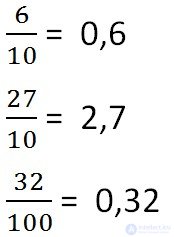Lecture
There is a special type of fractions - decimal fractions. They look like this: 5,6; 3.17; 0.17, etc. In fact, this is a special record of ordinary fractions, in which the denominator is 10, 100.1000.10000, etc. Such fractions agreed to record without a denominator. I.e:

First we write the integer part, and then we put a comma and write the numerator of the fractional part. Let's explain with examples.
Let us be given an ordinary fraction of 57/10. The denominator is 10. We count the number of zeros in the denominator. We have one zero. We count from right to left in the numerator of the fractional part one character (digit) and put a comma.
In the resulting decimal, the digit 5 is the integer part, the digit 7 (standing to the right of the decimal point) is the fractional part.

Let us be given an ordinary fraction 57/100. Again, count the number of zeros in the denominator. Now there are two.
Right-to-left, we count two digits (figures) in the numerator and put a comma. Since there are no 5 characters in front of the digit, then we add a zero before the comma.

If the number of zeros exceeds the number of characters (digits) in the numerator, then we put zeros on the missing places.
Let us be given a fraction of 39/10 000. We write it in the form of a decimal fraction. The denominator is 4 zeros. We count from right to left 4 characters (digits).
But we have only two digits in the numerator. Therefore, in two missing places we write two zeros.

Comments
To leave a comment
Arithmetic
Terms: Arithmetic